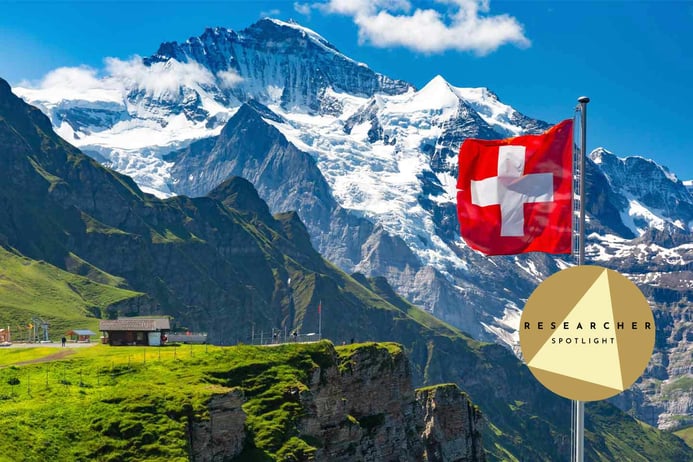Dr. Meng-Mei Maggie Chen (Assistant Professor of Marketing) and Amélie Keller (Flagship Resilient Tourism Coordinator), offer insights into their collaborative work with Nyon Région Tourisme and Blent Hospitality Business Intelligence.
En route to smart destinations
Through the Flagship Resilient Tourism Project, supported by Innosuisse and in collaboration with Canton Vaud’s economic and innovation promotion services, EHL Hospitality Business School has been leading a coaching program for SMEs in the Vaud region. This initiative equips businesses with digital tools and innovative data processes to empower local tourism stakeholders with the resources to optimize operations and develop resilient strategies.
The Q&A looks at what type of mindset and tools are required for a region to become a ‘smart destination’. From the first edition of the coaching program, an inspiring prototype dashboard has emerged as a shared platform to help tourism SMEs to integrate business intelligence and actionable data. A recent case study on Nyon Région Tourisme serves as an inspiring example of how innovative digital tools can be successfully implemented to transform and widen tourism operations. This proof of concept (POC) showcases an impactful, scalable model that could shape the future of resilient, smart destinations of all sizes.
How did the dashboard project emerge?

|
AK. It was a great coming together of synergies and collaboration that grew out of our local coaching project. Nyon Région Tourisme (NRT) had already come up with a plan to leverage data to manage the destination. They got in contact with Blent, the hospitality tech innovators, who just happen to be based in Nyon and who interestingly have been incubated at the EHL Innovation Hub for the past five years. Then our EHL team (Maggie, Alessandro Inversini and myself) stepped in as part of the Flagship initiative with the Call for Projects, to which NRT responded, presenting us with the embryonic stages of their dashboard idea. Our role as EHL researchers and coaches was to support them and provide data know-how, academic insights, conceptualization and design management expertise, e.g., identify the main KPIs displayed on the dashboard to fit industry needs. |
| MC. This initiative was born from local tourism SMEs needing to harness digital tools to create a better experience for visitors and make their operations smoother, more sustainable – but not always knowing how to do it. It was also driven by the desire to make ‘smart tourism’ a concept that is not just applicable to big destinations. Typically, a capital city has greater capacity and resources to invest in its digital innovation strategies, but who says that a small town like Nyon can’t be a pioneer in leading smart destination management in Switzerland? Our case study describes how in just a few months of collaboration, the dashboard prototype was successfully developed, propelling the region's digital transformation towards smart tourism. | 
|
From the NRT case study:
“Nyon Région Tourisme has partnered with Blent to harness real-time tourism data to gain deeper insights into customer behavior and tourist flows within the region. This initiative aims to transform the Nyon area into a Smart Tourism Region, bolstering the local industry, fostering tourism development, sharing best practices and promoting socio-economic growth. Over the past six months, NRT and Blent have worked together to develop a regional platform for displaying anonymized data from hotels, hostels, campsites and other accommodation, as well as data generated by the recently launched transport card and tourist offices. EHL Hospitality Business School has played a specialist advisory role, resulting in a successful and scalable POC project. These projects mark a significant stride toward a digitally transformed future for tourism in Canton Vaud, showcasing the power of innovation and collaboration.”
What’s the definition of SMART tourism?
AK. The concept of smart tourism, smart destinations or smart regions is all about using technologies with the purpose of collecting data, analyzing it and using the findings to best inform all aspects of operations, offers, marketing, revenue management, etc. With the right technology, this data can be transformed into unique and valuable business propositions that strengthen the connection between visitors, local stakeholders and residents. A smart destination brings together all kinds of data from physical infrastructure, community info and everyday behavior to create personalized experiences for visitors and develop smart business ideas for the region. With this NRT dashboard project, the aim is to expand it by including data not just from accommodation sites but also from restaurants, museums, events and transport to get a more complete sense of what drives tourism in the area.
In essence, sharing data among tourism stakeholders enables the creation of synergies and centralized information. For example, if you travel to a smart destination, you can use tourism apps that offer everything you might need – from personalized real-time recommendations to transport cards, discounts, ticket purchasing, itineraries, rentals, etc. Then tourism stakeholders can use all the data generated, anonymously, to understand visitor preferences, behaviors and tourism flows to further optimize their offerings. Data not only contributes to business decision-making processes, it also helps in creating a seamless, personalized and enriching journey for visitors: it’s a perfect feedback loop.
MC. Building on the success of the NRT project, we are currently working on a research paper based on concrete steps to becoming a smart destination. In the paper, we explain not only what smart tourism is, but also how the dashboards work and how NRT and Blent managed to get all tourism stakeholders on board. We hope that our research case study will inspire other destinations of all sizes to join the movement.
In what way is this dashboard a breakthrough for tourism SMEs?
AK. This dashboard gives a new level of data that SMEs in our sector have never had before. Bear in mind that many of the smaller hospitality/tourism firms have been very skeptical about integrating tech into their operations; with this type of tool, we can finally help them to understand the volume of data available and how to take advantage of it via a shared, collaborative platform.
MC. This type of data-driven tool is also useful for busting the many local tourism ‘myths’, replacing them with hard facts. For example, in Nyon, there’s the belief that the region attracts many Swiss German tourists – but is this really a fact? And if so, which cantons are they coming from? With the dashboard, hotels can better see where the tourists are actually coming from and take more informed actions. The POC functions on the technical aspect that Blent is collecting data directly from hotel PMSs (property management systems), hence the advantage of this new platform is that data is automatically synchronized on a real-time basis. It registers the information from all the sources as it arrives, rather than from reports sent to the national tourism bodies, who then take a long time to process and disseminate the findings.
Can we see this as a democratization of access to data?
AK. Among t of what tech means for them. The dashboard is a symbol of business intelligence made available to all strata ofhe different actors – from a big hotel chain to a small bed & breakfast – each has very different perceptions the tourism industry, so yes, in many ways, we are democratizing the access to data. Most of all, we are bridging the gap between local, regional and national, encouraging small firms to leverage tech solutions and dare to be as digitally ambitious in their operations as larger ones.
Is the next step to scale up nationally?
MC. The dashboard is currently available to 70% of hotels in Nyon, but it can easily be duplicated. It’s a perfect model for other areas in Switzerland wishing to exploit smart technologies in the tourism sector. The dashboard platform is more than just a tech project, it’s a gateway to smart destination management that should be used to inspire other regions in their own transition to more sustainable and connected tourism practices. For now, we are collaborating with Innotour to further develop this POC. The aim is to scale up our MVP (minimal viable product) by adding more data sources such as museums, restaurants, events, social media, as Amélie mentioned above, and implement the project with Lausanne Tourism.
AK. The flagship’s main aim is to accelerate the digitalization of Swiss tourism – at all levels. This improved data intelligence strategy is to strengthen the resilience and modernization of the sector, where possible, nationwide. The coaching program has also been built on this premise, with the project criteria based on scalability, regional impact and sustainability.
What were the challenges in implementing the POC?
MC. Unsurprisingly, not everyone wanted to share their PMS data with potential competitors, so it’s important to look at the bigger picture. EHL’s reputation has played an important role here: securing the trust from hoteliers for the greater good of the industry, all working together under the umbrella of a regional program which offers win-win benefits to all stakeholders. And, in any case, confidentiality is ensured since data is submitted anonymously and is not recognizable from its source.
AK. Gathering, managing and analyzing data can sometimes be tricky, especially with so many different information sources and players in tourism. Data comes from many places like visitor demographics, booking platforms, social media and on-the-ground operations, making it hard to get a clear, complete picture of a destination’s performance. Blent’s platform is a good first step in solving this problem – which is exactly the point of our Innotour project. We look forward to tackling this challenge in order to create a rich smart destination platform and evaluate how our partners manage to leverage the tool.
How has this project impacted you as EHL researchers?
AK. It’s been a really dynamic local project and I await to see its impact on a bigger scale. We started from scratch as an Innosuisse flagship coaching project that led us to Nyon Tourism, Blent, and soon Lausanne Tourism. As we go onto the next level, the project may also include bigger partners from the Swiss travel industry. All this is quite unique and far more than we’d expected. This is a great example of an industry-driven initiative that emerged from the flagship – proof that the flagship works and has an impact at industry-level. For now, the dashboard platform is just local to Nyon but is showing huge potential to scale up. Putting EHL researchers in this coaching role helps to position EHL as an industry supporter and innovator.
MC. It’s been a real bottom-up approach. One small destination that normally doesn’t get much attention could now potentially affect how Swiss tourism operations are carried out. When we presented the tool to the SME hoteliers, their faces lit up, they immediately got the value of the dashboard. We soon understood that this initiative is helping to address long-standing problems faced by Swiss tourism SMEs. For EHL research to be a pivotal part of such a breakthrough is very rewarding. Research is not just about producing complex papers for fellow academics, it’s about making a positive difference to processes and policies that impact society.
To find out more about the Resilient Tourism Flagship Project, listen here.





